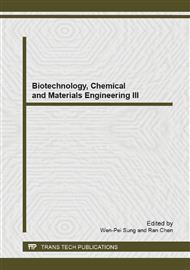p.566
p.570
p.574
p.578
p.582
p.586
p.593
p.598
p.603
Startup of Seawater Anaerobic Ammonia Oxidation Reactor
Abstract:
Muds and water samples collected from the Bohai Sea were selected to build seawater anaerobic ammonia oxidation reactor. The reaction volume was 18 L. The startup of reactor was divided into two stages. The first stage lasted five months and hydraulic retention time was 18L/7 d. The second stage lasted a month and hydraulic retention time was 18L/14 d. Ammonia and nitrite of influent and effluent were monitored. During the first stage, the removal rate of ammonia nitrogen was around 50% and the nitrite nitrogen increased by 50%. During the second stage, the removal rate of ammonia nitrogen reached more than 75% and the removal rate of nitrite nitrogen reached more than 90%. The removal ratio of ammonia nitrogen and nitrate nitrogen was about 1:1.17. These results suggested reactor start-up successful. Microbial community in reactor was monitored by polymerase chain reaction. Once the reactor started, specific bands of anaerobic ammonia oxidation microorganisms were found.
Info:
Periodical:
Pages:
582-585
Citation:
Online since:
January 2014
Authors:
Keywords:
Price:
Сopyright:
© 2014 Trans Tech Publications Ltd. All Rights Reserved
Share:
Citation:


